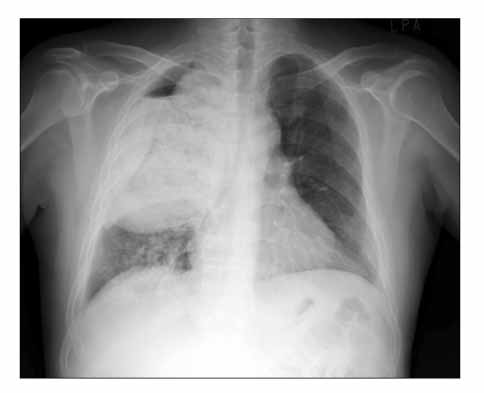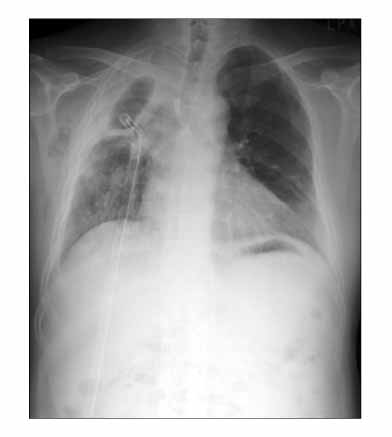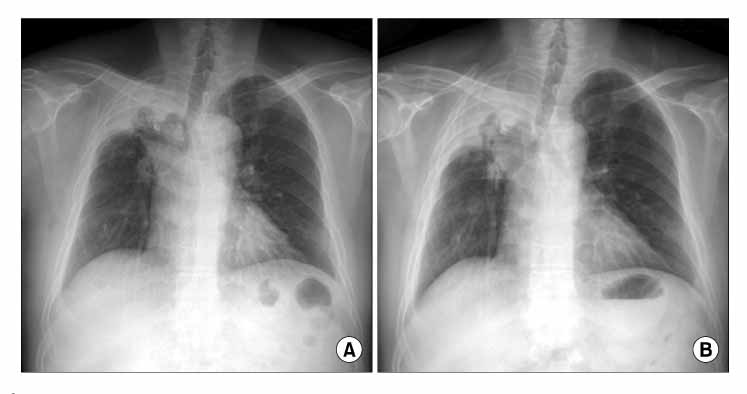Tuberc Respir Dis.
2007 Dec;63(6):507-510.
A Case of Bronchoscopic Treatment of a Bronchopleural Fistula Accompanied by Pneumonia
- Affiliations
-
- 1Department of Radiology, Donghae Hospital, Workers Accident Medical Coopration, Donghae, Korea. fovos@unitel.co.kr
Abstract
- A bronchopleural fistula (BPF) is traditionally treated by surgery, but currently various noninvasive forms of management, particularly the use of bronchoscopy, have been utilized. The substances and methods for noninvasive management of a BPF differ with individual clinicians. This case describes the use of flexible bronchoscopic treatment of a BPF complicating pneumoniausing embolization coils and intraluminally injected fibrin glue. If the BPF is small and is located on the peripheral bronchus, this minimal invasive maneuver could be recommended for the treatment of a BPF.
Keyword
Figure
Reference
-
1. Puskas JD, Mathisen DJ, Grillo HC, Wain JC, Wright CD, Moncure AC. Treatment strategies for bronchopleural fistula. J Thorac Cardiovasc Surg. 1995. 109:989–995.2. Lois M, Noppen M. Bronchopleural fistulas: an overview of the problem with special focus on endoscopic management. Chest. 2005. 128:3955–3965.3. Galetta D, Veronesi G, Solli P, Petrella F, Borri A, Gasparri R, et al. A safe and effective method for an immediate bronchopleural fistula repair. Minerva Chir. 2007. 62:137–139.4. Hartmann W, Rausch V. New therapeutic application of the fiberoptic bronchoscope. Chest. 1997. 71:237.5. Na KJ, Kim BP, Hong SB, Choi YS, Kim SH, Ahn BH. Endobronchial closure of postoperative bronchopleural fistula using vascular occluding coils. Korean J Thorac Cardiovasc Surg. 2005. 38:72–75.6. Choi YI, Cho JH, Shim JY, Sheen SS, Oh YJ, Park JH, et al. A case of RUL bronchopleural fistula occluded by flexible bronchoscope with Endobronchial Watanabe Spigot (EWS). Tuberc Respir Dis. 2005. 58:404–409.7. Varoli F, Roviaro G, Grignani F, Vergani C, Maciocco M, Rebuffat C. Endoscopic treatment of bronchopleural fistulas. Ann Thorac Surg. 1998. 65:807–809.
- Full Text Links
- Actions
-
Cited
- CITED
-
- Close
- Share
- Similar articles
-
- Bronchoscopic Treatment of a Bronchopleural Fistula with using Coils and Fibrin Glue: A case report
- Use of the Free Flap for Large Defect with Bronchopleural Fistula: Case Report
- Closure of a Postoperative Bronchopleural Fistula with Bronchoscopic Instillation of n-butyl-2-cyanoacrylate (Histoacryl(R))
- A Case of Peripheral Bronchopleural Fistula Treated by Flexible Bronchoscopy with Gelfoam Occlusion
- Peripheral Bronchopleural Fistula: CT Evaluation in 22 patients





